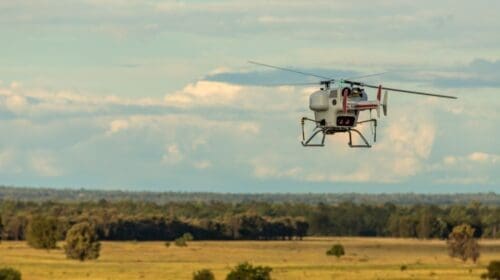When change surfaces, opposition typically erupts, fueled primarily by fear. Instead of embracing change as an avenue for possible improvement, people often attempt to combat it on multiple fronts. History, however, has revealed that change always wins in the end. The energy transition, once considered an unrealistic phenomenon, has become a reality. The horn has sounded, and the train has stopped at the station: The energy transition has arrived.
No one knows and understands this more than Rob Threlkeld, Director of Global Energy Strategy at General Motors (GM). As the company contributes to the energy transition, it also plays a vital role in guiding the firm to meet its carbon neutrality goal by 2040. This is just one change he and GM have embraced while others still fight the reality of the train’s arrival.
While many might need help to clear a path to success in achieving carbon-neutral goals, Threlkeld finds himself placed exactly where his personal goals, beliefs and passion can be achieved and measured by GM’s direction and accomplishments in the renewable sector. Not everyone finds true happiness and fulfillment in their career. Threlkeld’s arrival at GM seems preordained by his early recognition of environmental concerns and how he could leverage an impact by helping provide a solution.

Early Detection
Inspiration comes in various forms and, for each impact, it is truly a unique and personal experience. For Threlkeld, his passion for the environment came early, not from a bitter experience, but something sweet.
“I love maple syrup and was concerned about the effects of acid rain on the maple trees in the New England States. I was in the second grade, and this sparked my interest in what I could do to help the environment.”
Participating in various climate change studies throughout high school, his passion for protecting the planet continued to grow. His love for meteorology and weather continued to draw his interest and fuel his concern. Threlkeld went on to Purdue University and studied civil engineering, focusing on hydraulics and environmental background.
Threlkeld began his career early in his studies at Purdue, entering the co-op program after completing his freshman year, working give successful rotations at General Electric, and completing his bachelor’s degree in 1998. The real-life work experiences gained during co-op rotations proved a good fit, and he realized he could further his reach in advocating for the environment. He returned to Purdue, earning a master’s degree in civil engineering. Then, his focus would begin and lead him to the energy transition. He entered the energy space at GM, where his career has grown for the past 23 years.
“I’ve operated some of our largest powerhouses and done contracting and worked for some of our largest facilities. When renewables kicked off, that is what really sparked my interest.”
He adds, “In 2005, we had some of our first rooftop solar arrays out in California at our parts distribution center, and that is what really got me moving in the renewable energy space.”
From that initial awareness of environmental issues that began in elementary school, Threlkeld understood his life direction would embrace this passion and the personal responsibility he carries. GM proved to be the ideal location for his career to take root. He points to GM’s size and reach, making it easier for him and the company to enact change quickly and effectively. He understands that GM provides him the means to drive his energy transition goals because of the company’s scale and because their goals are aligned.
Threlkeld indicates that GM embraces renewable energy sources and their importance in the energy mix. The significance is clear, and routes of successful transition rely heavily on cost and reliability.
“We really have to focus on cost and reliability as we decarbonize. It’s no different in what I have to pay for my utilities as I look at the company’s efforts as well. We are very much aligned and have top-level support.”
Drawing on multiple examples of alignment, Threlkeld compares what he and others do at home with GM’s scalability. He takes personal steps at home that catalyze GM’s efforts in the professional world.

“I’m a huge Clark Griswold fan and have tons of Christmas decorations. By going all LED, I have reduced my electric bill to lower than what it was during the summer months.”
This is another example of Threlkeld taking action to reduce energy consumption, much like how GM approaches the cause. His personal beliefs about the importance of the energy transition carry over into how GM makes its own contribution.
Four Pillar Strategy
According to Threlkeld, GM remains committed to impacting the renewable energy sector and strengthening the electrical grid. That impact can be recognized through multiple vantage points. While the company seeks local solutions, the effect is felt globally. Across the board, GM has procured over 1700 megawatts of renewables within its footprint of manufacturing locations.
“GM is one of the largest corporate procurers of renewable energy,” says Threlkeld. “On a global level, we are either 12 or 13.”
To accomplish this feat, a robust planning and resource allocation strategy must be subjected to great thought and consideration. Threlkeld points to GM’s four-pillar strategy, amplifying its commitment to a clean energy future by working to secure the renewable energy needed to power all its U.S. facilities by 2025, global facilities by 2035.
“The first pillar takes a detailed look into energy consumption,” says Threlkeld. It concentrates on energy efficiency made through investments in new advancements of technology and GM’s efforts to conserve electricity use within its own facilities. The company tallies $20 million in annual expenditures for energy efficiency and power demand projects.

GM’s second strategy directs attention to sourcing renewables through multiple methods, such as green tariffs and power purchase agreements. Wind, solar and landfill gas have become areas of concentration. Threlkeld indicates that renewable energy sources from new state projects help power GM’s Michigan sites.
Some opposition to the energy transition claims that renewables lack reliability because some sources – including wind and solar options – are intermittent in the energy they provide. According to Threlkeld, GM responds to this argument with its third pillar of addressing intermittency through energy storage and battery power solutions. The company is working to determine how EV batteries can be reused after their first vehicle life cycle.
The final pillar of GM’s strategy draws on each and addresses leveraging policy and scale. Threlkeld says it is here that GM integrates its efforts to increase scale for grid decarbonization and reliability.
“In many ways, a number of our renewables have been procured through green tariffs through our own utilities. It is working and getting those types of tariffs approved either by public utility commissions, legislature and through our advocacy efforts that allow us to continue to scale up.”
Managing Responsibility and Challenge
According to Threlkeld, passion largely navigates how he manages his responsibilities in his role at GM. His internal team and networks generated outside of GM are critical in establishing direction and goals.
“You have to set that North Star.”
He relies heavily on time management to fulfill those responsibilities but also takes the time he needs to remain informed of advancements made in his area of expertise outside of GM. He adds that “leveraging the information resources” helps grasp where the industry is headed as a whole.

As organized and driven as Threlkeld is, he is not immune from challenges. Instead of typical examples of difficulties, such as budgetary concerns or supply chain shortages, he identifies the energy transition’s speed as the most significant challenge he must endure.
“The grid will need to be doubled in the next 10 to 15 years to electrify everything. The amount of infrastructure that needs to be developed keeps me up at night.”
Threlkeld manages that burden by relying on his personal life. His love for his family and swimming both led him to coaching, where the sport allows him to destress and have a positive impact on young people.
“Sports are a de-stressor. They teach kids how the world works. Team captains play a role as a stopgap to the coach. They set goals and solve problems much like is done in the business world.”
As much as Threlkeld gains personally from coaching and officiating swim meets, the youth walk away with even more. He takes pride in telling his swimmers what they should think about instead of what they should be doing. This is a significant step in developing the critical thinking skills needed for the energy transition’s future and the world in general.
Sometimes, an individual must take advantage of the silence to hear what is happening in their world. Threlkeld says he subscribes to this strategy without compromise. He enjoys six-to-eight-mile walks every day to unwind and compile his thoughts.
“I love watching sunsets and looking at decorations. That’s another de-stressor for me. I have seen shooting stars, [and also] deer and foxes run across the road. Sometimes, I stop and talk to neighbors if they are outside.”
Securing the Energy Transition’s Future
Threlkeld sees a clear and achievable energy transition across multiple areas of everyday life, affecting every citizen. The utility sector alone is an excellent candidate to be transformed due to its age and the upgrade work needed. The energy transition touches the transportation sector as it continually moves to electrification.
“You have a system-level change taking place,” he says.
Threlkeld identifies the need to address load growth and reliability when considering the energy transition across the electrical grid. As utility providers work to upgrade their facilities, the rate or number of outages must be addressed to decrease their occurrences and prepare them for restoration should an outage be unavoidable.
Acknowledging that it is a tall order to ensure the future of the renewable energy sector, significant steps can be made in transitioning from fossil fuels to clean energy through the collaboration of company resources. Threlkeld is vice chair for the Clean Energy Buyer’s Association, a group of 14 companies that joined forces in 2013 to scale up renewables and set a path to decarbonize up to 90 percent by 2030.
Group effort enables a better rate of success. Threlkeld continues to wage his impact on the renewable sector as a member of the Virtual Power Plant Partnership, Zero Grid Initiative, and the Emissions First Partnership. Additionally, he sits on the Environmental Ecological Engineering External Advisory Council at Purdue and concentrates on course curriculum and research within the civil engineering school, focusing on methods to make clean energy possible.
For all of his efforts, Threlkeld sees the fruits of his labor. He remains steadfast in knowing his contribution has impacted how the world will be powered. Recently named a Notable Leader in Energy, Threlkeld appreciates having his commitment highlighted by society.
“I am very honored to be named [and] my kids were really excited.”

Threlkeld seizes every opportunity available to impact the energy transition further. These are not exclusive to his actions but also ensure others take the necessary steps to become educated, embrace the need, and make their own impact. He uses his love for coaching swimming and working in a high-profile position for a major corporation as a platform to help steer the youth as they will be tasked with continuing the energy transition but also assisting them in realizing their dreams.
“I’ve helped steer kids into various different programs that have led them to what they ultimately wanted to pursue in life. They have asked questions about my career and I answer them.”
While the youth will advance long after the world succeeds in decarbonization and electrification, Threlkeld believes every citizen is responsible for ensuring the energy transition succeeds. While cost typically serves as a driving force or catalyst for making most decisions, some will remain skeptical of the potential of decarbonization and electrification. Flexibility will be the key to success for each to initiate their own impact.
Each individual can control the energy they use and waste. Conserving electricity, monitoring thermostats, and embracing battery power are some options available for each person, while others might retrofit homes with solar panels. Each solution makes its impact.
“All we have to do is use the tools at hand,” says Threlkeld, “and we can each make a personal contribution to making a clean energy future a reality.”
Nick Vaccaro is a freelance writer and photographer. In addition to providing technical writing services, he is an HSE consultant in the oil and gas industry with twelve years of experience. Vaccaro also contributes to SHALE Oil and Gas Business Magazine, American Oil and Gas Investor, Oil and Gas Investor, Energies Magazine and Louisiana Sportsman Magazine. He has a BA in photojournalism from Loyola University and resides in the New Orleans area. Vaccaro can be reached at 985-966-0957 or nav@vaccarogroupllc.com.
Oil and gas operations are commonly found in remote locations far from company headquarters. Now, it's possible to monitor pump operations, collate and analyze seismic data, and track employees around the world from almost anywhere. Whether employees are in the office or in the field, the internet and related applications enable a greater multidirectional flow of information – and control – than ever before.









